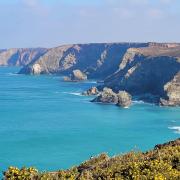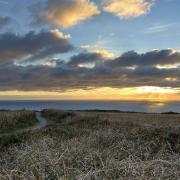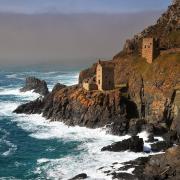Let your dog explore the sights and smells of Cornwall with these ten dog-friendly routes
1. Frenchman's Creek
Park in the layby outside Kestle Barton, an ancient Cornish farm-turned-gallery, and take the public footpath on the opposite side of the road. You will be led through some woodlands to the edge of the Helford. Here, the path splits into two; the left will take you on a short and overgrown route to Withan Quay, however, if you keep right you will be on your way to the Helford Village. The path hugs the edge of the river, giving you glimpses through the trees of the still creeks and amazing birdlife. Spring is a fantastic time to visit as wild garlic is in bloom, meaning the air smells incredible and the floor is a carpet of white.
The path eventually turns to a farm track which will lead you past a field of daffodils; breath-taking when still in bloom. Continue until you come to a road and take the immediate left turn signposted to the Helford. You will head through more woodlands before coming to the quiet Penarvon Cove. The path continues on the right, leading to the picturesque Helford Village; thatched cottages set on the still waters of the ancient river. Now a sleepy hamlet, this area was once a busy trading port frequented by traders and pirates, the perfect setting for an adventurous smuggling novel. Here you can stop in at The Shipwright's Arms to sit by the river, take in the views and enjoy some local ales.
To finish your walk, head through the village and over the small bridge. Take the immediate right turn and follow the signs through the woods back to Kestle Barton, stopping off to enjoy the rope swing on your way! You will pass livestock fields so keep your dog on a lead. Before you reach your car, you can enjoy the grounds of Kestle Barton, appreciating the historic buildings or seeing some local art displayed in the gallery - dogs welcome!
Bins, toilets and refreshments in Helford Village.
2. Gurnard's Head
Many people know the name The Gurnard's Head due to the bright yellow pub nestled at the side of the road between St Just and St Ives. But behind the pub lays one of the most beautiful areas of Cornwall; a stunning cove with turquoise water, all overlooked by relics of Cornwall's past; including an Iron Age Fort, two mining ruins and the remains of a medieval church.
Begin your walk to the right of the pub and follow the path through the hamlet. A signpost points in two directions; however stick on the right-hand side on the path to go down through the valley, giving you stunning views and an opportunity to get close up to the mining remains. The path takes you down to the furthest mine. From here, you can make your way down to the beach or you can head back around the ruin and take the thin path which leads up the hill towards the headland. You will pass over a small bridge and then continue along the path towards the fort. It is recommended that you keep dogs on leads during this walk as the fall from the cliffside is steep. On the right of the path, a set of steps leads down to the stone outline of a small building. This is the remains of a medieval church.
Following the path, you can access the headland, named because it is said to resemble the head of a gurnard fish. In Cornish, it is named 'Ynyal', meaning 'desolate'. But at one point, it would have been far from it. The remains of two ramparts can still be found here; the remnants of an Iron Age fort. There are thought to have been around 16 roundhouses once here, which would have housed a small community of people.
On your way back, you could continue left towards Porthmeor Cove, or you can head back down the way you came and before you reach the bridge, turn right through the gate and into a field. These fields, separated by the most stunning Cornish walls, will lead you back towards the road. Beware of livestock and keep your dog under control.
3. Trevaylor Woods
Trevaylor Woods near Penzance is the perfect hidden gem for a dog walk. Access to the woods is down a bumpy slope, the entrance of which is marked by two dog bins. The bottom opens up to some of the most charming woodlands in the county; characterised by lots of tall beech trees and a shallow river running through the middle. The woodland is charming - and especially so in the autumn, when the vapour swirls up from the river and the multi-coloured leaves litter the floor. It is a fantastic walk for children as well as dogs, as the moss-covered trees with twisted branches have a magical essence about them and the triangular-shaped holes in the bases of some trunks give an appearance of fairy doors.
The woods are really tranquil; quiet except for the sound of running water. As you walk you will see evidence of previous human activity, such as concrete gates posts and metal-looking contraptions. The nearby village is 'New Mill', suggesting the water flow would have once been used as part of a corn mill which would explain these features.
There are few places to cross the river, but the homemade wooden bridge provides a fun way to explore the other side. The trees eventually end, however you will reach a small stone style, which leads to a thin field, and at the other end another field where you can continue your walk towards New Mill.
4. Nanjizal Beach
Many people know about the tucked away beach of Nanjizal due to its fascinating rock formation, a natural archway known as the Song of the Sea, however not many people know about the beautiful two-mile walk from Porthgwarra.
Used as a filming location for the popular series Poldark, Porthgwarra is a great starting point, with a car park, café and some exquisite views. The coast path begins to the right of the beach and will take you along some of the most beautiful parts of the South West Coast Path.
One of the first places you will come to is Gwennap Head; home to a watchpoint for the National Coastwatch Institution (NCI). The lookout point is open to the public and the volunteers who run the service are always happy to have a chat about their work.
Continuing the walk will give you great views over the Atlantic Ocean and on a clear day you can see for miles. Be very careful as the path can veer quite close to the cliffs in some areas and it is recommended that dogs are kept on leads for their own safety.
You will eventually be guided inwards, letting you further observe some of the stunning landscape. The paths are lined with heather and gorse, which gives a beautiful coconut fragrance as you walk and is a great place for budding entomologists to spot beasties such as dor and oil beetles.
Eventually, you will be guided down to the beach. Due to the fact, it is slightly difficult to get to; Nanjizal tends to be fairly quiet. It did become briefly popular after it was revealed to be the filming location for several Dr Who episodes in 1966. There are lots of caves and rockpools here for those who are not content with just enjoying the turquoise water and famous white sand. The beach has some beautiful features, such as the engine house ruins which sit above the sand and the two streams which fall down to meet the ocean.
There is parking, public toilets and bins at Porthgwarra.
5. Mousehole
Mousehole is famous for its fabled feline resident, but it can be the perfect place for canines too. Beginning at the harbour, walk through the town and follow the winding roads upwards. On the way, you will pass traditional Cornish cottages, quaint shops and Mousehole Bird Hospital. The hospital has been in action for 90 years and is free to visit so stop off and admire their incredible work.
As you reach the top of the hill, you will see a sign marking the coast path pointing to the left. Here, you will pass by a couple of houses and onto the path which takes you around the cliffs. There is a footpath here which takes you inland to Lamorna, but the coastal walk has some incredible views and shouldn't be missed. The walk will take you towards the cliff edge and then veer away again, leading you through a woodland nature reserve. After you leave the trees, you are back overlooking the sea again - lookout for St Clements Island. After hopping over stiles, you will finally begin to turn right, taking you into Lamorna. Grab a coffee from the café and your dog can cool off in the turquoise water.
6. Bodmin's tors
Sometimes it's okay to come second, and when it comes to exploring tors in Bodmin, the second-highest, Rough Tor, is definitely not one to miss. Pronounced 'Rowtor', it stands tall at 1312ft high and is a fantastic place to visit if you're a bit of a history buff.
You can start at the car park which is about a mile and a half from the tor's top summit. Cross the bridge and begin the ascent. There are some fascinating pit stops you can make along the way to the top, including a memorial to Charlotte Dymond, an 18-year-old girl who was murdered on Rough Tor and whose ghost is still said to roam the moor. There is also a plaque dedicated to the men of the 4th Wessex Division who died during the Second World War, but the rocks here form one of the main historical draws. Rough Tor was once inhabited by humans and ancient remains can still be found, including the boundaries of homes of those who lived here from 2000 BC. There are 120-plus hut circles that have been dated to the Bronze-Age and Time Team dedicated a show to investigating the western slope. Rough Tor would have been chosen as a dwelling due to its advantageous lookout point, but the weather sometimes prevents this from being fully appreciated! When we visited, the mist was thick, however, it is said that on a clear day, you can see both the North and South coasts of Cornwall.
Walking boots advised as there are steep inclines. The car park can be accessed from Rough Tor Road, by following the signs. There are no other facilities, so take your own drink for yourself and your four-legged friend.
7. Loe Bar
The coast near Loe Bar is well known due to the rip tides, but the coast path here is exquisite and a walk that everyone should do once in their lifetime. The views are incredible, and the surrounding fields mean that the flora and fauna here is often at their best.
Turn off the A3803 opposite the entrance to RNAS Culdrose and continue down to Chyvarloe Farm. Park in the small car park at the end of the track. From here, the path suggests you should continue down to Loe Bar, but instead, turn off down the single lane track on the left. The hedgerows attract a lot of butterflies and birds. As you continue, these hedgerows fall away and are replaced by fields, giving you fantastic views down over Loe Bar.
As you walk, the path veers round to the left, flanked by fields inland and the sea on the right. Beneath you, a strip of golden sand stretches all the way to Halzephron Cove. You will need to be careful along this walk, as the cliffside has some steep drops. Make sure dogs are kept on leads to prevent accidents. The coast path will take a slight ascend past Baulk Head, which is the start of a Site of Special Scientific Interest (SSSI) stretching to Mullion. It has been awarded the status due to some endangered plant species such as hairy greenweed and wild leek. The path will continue, taking you past Halzephron House and round to Halzephron Cove. The beach here is inaccessible by foot due to the sheer drop and 'Halzephron' actually translates as 'cliff hell' due to the amount of shipwrecks that have occurred offshore. This is enhanced as you reach Pedngwinian. Don't get too close to the edge here as the drop is around 200ft, but the view is dramatic. As you continue walking, the path begins to slope downwards and Dollar Cove looms into view. This beach is dog friendly all year round so is a great place for you and your dog to cool off. You can continue to follow the path past the golf course and Church Cove to Poldhu if you wish to walk further.
8. Rame Head
Rame Head heritage coast, sometimes referred to as the 'forgotten corner', is tucked just outside of Plymouth on the South coast and many people pass by without stopping to enjoy the breath-taking beauty that this part of the coastline offers. The area has some incredible walks, but one of my favourites is a short jaunt to Rame Head Chapel, perfect for those who want to enjoy the scenery but do not wish to walk far.
Exit the car park through a kissing gate and into a field that sometimes has Dartmoor ponies grazing. Continue towards the chapel on the headland, following the path. The walk leads you through what was once an Iron Age fort; this is just one of the amazing historical features of the area. The Celts built a rampart here to defend the area from attack and a Medieval chapel from which monks used to burn lamps to warn sailors of the dangerous rocks below. But one of the most vital roles this area played occurred during the arrival of the Spanish Armada in 1588, as it is said that from here, the beacons were lit that gave the first warning of the ships anchoring below.
Upon arriving at the headland, you will be rewarded with panoramic views over the sea, as well as the beautifully basic chapel which still stands. In 981, the chapel was gifted to Tavistock, meaning that it was considered to be in Devon! But no matter where Rame Head technically is, the views from the headland make you feel as though you are on top of the world.
9. Rosewall Hill
It would be easy to miss Rosewall Hill. Its little car park is tucked on the side of the road between Zennor and St Ives, highlighted by a small National Trust sign. But this walk is not one to pass by; it gives you some incredible views over the North Cornish coast.
Go through the small iron gate and make your way up the hillside. The path leads you between the old mining shafts that were once in operation here. Tin mining has been carried out here since the Prehistoric period but, like large parts of Cornwall, was particularly important during the 19th century. It is estimated to have manufactured 16,000 tonnes of tin during the height of its production. The shafts are sealed off, but there is some information you can read that will give you a better understanding of the work that went on here. Be sure to look closely though; there is an old myth that the mines in the area are home to a group of 'knockers' or 'Buccas', Cornish water spirits which may grant wishes in return for offerings of food.
If you continue up the path, you will come to a rock formation at the summit. Be careful, as these are surrounded by an electric fence to prevent free-roaming cattle from getting in. You and your dog can enter, however, after unlinking the fence, and it is here that you can get incredible 360-degree views of the area, including St Agnes and Portreath on a clear day. Old Chimney stacks and Iron Age and Neolithic remains are notable landmarks you can see from the top. You can either make your way back down the way you came or head back down the hill on the opposite side where paths will lead you back to the car park.
10. Trewardreva Mill
Just outside Constantine, tucked away from the road at Trewardreva Mill, the tiny village has a hidden secret worth discovering.
Pull into the small car park near the 'Trewardreva Mill' place sign and follow the path as it takes you through an old quarry and to a stunning woodland which is home to the disused corn mill, was once powered by the local stream. The woodland is in a valley and as you pass by some stone steps, the path here splits into 3, giving you multiple options to enjoy the area; you can walk down by the stream, through the middle of the woodland or on the path at the top of the valley, giving you great views of the area. If you take the path nearest to the fresh water stream, there are many opportunities your dog can access the water, this is also the best place to get closest to the mill itself.
May is a fantastic time to visit the woodlands as the floor is littered with bluebells, causing the ground to erupt in shades of blue and purple during the spring months. The scent, accompanied with the dulcet tones of the flowing water, makes this a tranquil and relaxing place to visit.
After leaving the woodlands, why not take a stroll through the tiny village? Reported to have once been linked to the 'fogous'; underground structures found in Iron-Age Cornish settlements, possibly used for praying, as food stores or as places to take refuge. Some of the houses in the village are Elizabethan and at the other end of the village, the restaurant 'The Waymarker' has a dog-friendly covered area where you can take the load off with some award-wining food and drink.



























